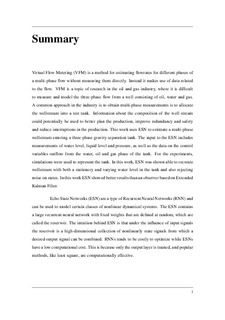Echo State Networks for Virtual Flow Metering in Gravity Separator
Master thesis

Permanent lenke
http://hdl.handle.net/11250/2631160Utgivelsesdato
2019Metadata
Vis full innførselSamlinger
Sammendrag
Virtuell volumstrøm estimering (Virtual Flow Metering, VFM), er et begrep som innebærer å estimere volumraten for de ulike fasene i en fler-fase volumstrøm uten å måle de direkte. Istedenfor så brukes data som er relatert til volumstrømmen. Det er interesse for dette fra olje og gas industrien, hvor det er vanskelig å måle og modellere en tre-fase-volumstrøm fra en oljebrønn som inneholder fasene olje, vann og gass. En vanlig praksis i industrien i dag er å dirigere volumstrømmen i en testtank en gang i måneden. Informasjonen om strømningen kan potensielt bli brukt til å bedre planlegge produksjonen, forbedre redundansen og sikkerheten og redusere stans i produksjonen for målinger av volumstrøm. Denne oppgaven Echo State Networks til å estimere fasene i denne volumstrømmen med date fra en tre-fase-gravitasjonsseparator. Det ble gjennomført eksperimenter med en simulator av en tre-fase-gravitasjonsseparator. ESN klarte å estimere de ulike fasene med både varierende og stasjonert vannivå, og under støy.
Echo State Network (ESN) er en type rekurrente nevrale nett og kan brukes til å modellere ulike typer ulineære dynamiske systemer. ESN inneholder et stort nettverk av vekter som er tildelt tilfeldig. Intuisjonen bak ESN at om man har mange nok tilfeldige tilstander med en ulineær aktiveringsfunksjon så er sannsynligheten stor for at det eksister det en kombinasjon av de til å modellere systemet. Rekurrente nevrale nett krever ofte mye tid å trene mens ESNs er et unntak og er "billig" å trene. Dette er fordi de bruker en lineær regresjonsmetode til å trene og det bare utgangslaget som blir trent. Virtual Flow Metering (VFM) is a method for estimating flowrates for different phases ofa multi-phase flow without measuring them directly. Instead it makes use of data relatedto the flow. VFM is a topic of research in the oil and gas industry, where it is difficultto measure and model the three-phase flow from a well consisting of oil, water and gas.A common approach in the industry is to obtain multi-phase measurements is to allocatethe wellstream into a test tank. Information about the composition of the well streamcould potentially be used to better plan the production, improve redundancy and safetyand reduce interruptions in the production. This work uses ESN to estimate a multi-phasewellstream entering a three-phase gravity separation tank. The input to the ESN includesmeasurements of water level, liquid level and pressure, as well as the data on the controlvariables outflow from the water, oil and gas phase of the tank. For the experiments,simulations were used to represent the tank. In this work, ESN was shown able to recreatewellstream with both a stationery and varying water level in the tank and also rejectingnoise on states. In this work ESN showed better results than an observer based on ExtendedKalman Filter.
Echo State Networks (ESN) are a type of Recurrent Neural Networks (RNN) andcan be used to model certain classes of nonlinear dynamical systems. The ESN containsa large recurrent neural network with fixed weights that are defined at random, which arecalled the reservoir. The intuition behind ESN is that under the influence of input signalsthe reservoir is a high-dimensional collection of nonlinearly state signals from which adesired output signal can be combined. RNNs tends to be costly to optimize while ESNshave a low computational cost. This is because only the output layer is trained, and popularmethods, like least square, are computationally effective